St Tysilio’s Chapel and the Menai Bridge, the world’s first large-scale suspension bridge
FOR AS LONG as anyone can remember, the island of Anglesey has been separated from the mainland by its own very effective moat, the MENAI STRAIT, 12 miles (19 km) of surging tides, treacherous sandbanks and whirling currents, 600 ft (180 m) across at its narrowest point. Today, according to the European Union, Anglesey no longer qualifies as an island, thanks to the success of two unique bridges.
The MENAI BRIDGE, designed by Thomas Telford and opened on 30 January 1826, was THE FIRST SUSPENSION BRIDGE IN THE WORLD CONSTRUCTED TO TAKE HEAVY TRAFFIC. At the time it was built it was THE LONGEST BRIDGE IN THE WORLD, 1,265 ft (386 m) in length, with a main span of 579 ft (176 m) hung from wrought-iron chains and suspended 100 ft (30 m) above the high tide mark, allowing plenty of room for ships to pass underneath. In 1839, the deck of the bridge was damaged by strong gales, and it has been replaced twice, once in 1893, and most recently in 1940 with a steel deck.

As well as being an engineering wonder, the Menai Bridge is utterly beautiful. When seen from the A4080 viewing point to the west, it looks like an integral part of the landscape, the graceful lines of the bridge blending seamlessly with the undulating shapes of the Snowdonia mountains behind.
On the Anglesey side, on a little promontory below the bridge, there is a reminder of the times when it was not so easy to reach the island. A small 14th-century church sits on the site of a chapel founded in AD 630 by St Tysilio, where travellers could rest and pray, or give thanks, for a safe crossing.
A little to the west is the BRITANNIA BRIDGE, opened in 1850 to carry the Chester to Holyhead railway across the Menai Strait. Designed by Robert Stephenson, son of railway pioneer George Stephenson, this was THE FIRST MAJOR TUBULAR BRIDGE IN THE WORLD. It consisted of two wrought-iron tubes of 479 ft (146 m) in length, along with two additional spans of 230 ft (70 m), set 100 ft (30 m) above the water and supported on limestone piers.

Originally, it was intended to hang the tubes from chains, rather in the manner of Telford’s Menai suspension bridge but, in testing, the tubes proved immensely strong and quite capable of bearing the weight of the trains on their own. The holes from which the chains were to be slung can be seen at the top of the piers.
In 1970, a couple of local boys exploring the tubes dropped a burning torch and set fire to the bridge, which had to be closed for four years. It was reconstructed without the tubes, using a conventional arch structure, an option made possible by the fact that clearance was no longer needed for large ships to pass underneath. In 1980, a road deck was opened above the railway, and this now carries the A55 across to Anglesey. The monumental stone lions that guarded the original bridge still stand sentinel at each end.
As their famous bridges stand side by side across the Menai Strait, so Thomas Telford and Robert Stephenson rest side by side in Westminster Abbey.
The best view of the two bridges is from the top of the 90 ft (27 m) high marble column built on the edge of his estate, in 1816, to commemorate the 1ST MARQUESS OF ANGLESEY, second in command to the Duke of Wellington at the Battle of Waterloo. The climb up 115 rickety steps is rewarded with one of the great views of the world, taking in the whole of Anglesey, the Menai Strait, the mountains of Snowdonia as well as the distant hills of the Lleyn Peninsula. To stand before this stupendous panorama, protected from the drop merely by a thin iron railing, with the wind buffeting the column and threatening at any moment to pluck you from the flimsy platform, is a truly exhilarating experience.

Sharing the view from the top of the column is a bronze statue of Henry Paget, the 1st Marquess of Anglesey, added in 1860. At Waterloo, while seated on his horse beside the Duke of Wellington, the Marquess, or the Earl of Uxbridge as he then was, had his leg shattered by a canon shell, an uncomfortable experience which caused him to exclaim, ‘By God, Sir, I’ve lost my leg!’
‘By God, Sir, so you have!’ replied the Duke, before resuming his examination of the battlefield through his telescope.
Later that same day Lord Uxbridge had the remains of his leg amputated, and on his return to London he was advanced to the Marquessate of Anglesey and given a wooden leg. He went on to have 18 children and 73 grandchildren and lived to the noble age of 86. His wooden leg, THE FIRST ARTICULATED WOODEN LEG EVER MADE, can be seen in the Military Museum at PLAS NEWYDD, the Marquess of Anglesey’s elegant 18th-century home on the banks of the Menai Strait. The house, designed by James Wyatt, is now owned by the National Trust, and the Dining Room contains THE LARGEST PAINTING EVER COMPLETED BY REX WHISTLER, a panoramic ‘mural’, 58 ft (18 m) wide, painted on to a single piece of canvas.
THE COASTAL ROAD to BEAUMARIS from Menai Bridge is one of the most attractive in the whole of Britain. It winds and dips past elegant villas that gaze out across the water towards the dark green of Snowdonia, and there are tantalising glimpses of glittering blue sea through the trees.
Arriving in Beaumaris itself is no disappointment. The woods and the vistas open out in spectacular fashion on to the ‘beau marais’ or ‘beautiful marsh’ that gives the town its name. The Great Orme looms on the horizon, while yachts and pleasure boats bob up and down against the lowering black backdrop of the cliffs at Penmaenmawr on the mainland. Two miles (3.2 km) across the water is the Lavan sandbank, from where ferries and mail packets once crossed to Beaumaris, with passengers and mail for Holyhead and Ireland.
There is a genteel, undeniably ‘English’ feel to Beaumaris, which is hardly surprising since, at the end of the 13th century, the native Welsh inhabitants of the original village, called Llanfaes, were forcibly moved across the island to start again at Newborough, freeing up space and material for King Edward’s new castle.

On the seafront of Beaumaris, a short pier and a huge expanse of smooth green lawn, laid down on land reclaimed from the marshes in 1832, are overlooked by a dignified mix of elegant Georgian houses and impressive Victorian terraces. The latter were built by Joseph Hansom, of Hansom Cab fame, who also was responsible for the ‘model’ town GAOL of 1829, a shining example of a progressive and humane Victorian prison system. There were separate cells for women and children, each cell had running water, and you can still see the drunkards’ cell, the soundproof isolation room, the whipping room and THE ONLY TREADWHEEL IN BRITAIN STILL IN ITS ORIGINAL POSITION. There is also an intriguing crank that was used as a particularly cruel and mind-numbing punishment, with a prisoner’s meals being dependent on the number of turns completed – 2,000 for breakfast, 3,000 for supper and so on.
Apparently, no one ever escaped from Beaumaris Gaol. In 1862, the last inmate of the gaol to hang, a man called Richard Rowlands, put a curse on the nearby church clock as he went to the scaffold, vowing that the four faces would never again show the same time. And, indeed, until the clock was given an overhaul in 1980, each face displayed a slightly different time.
Beaumaris was Anglesey’s first county town. It was also an administrative and legal centre, and the restored Jacobean COURTHOUSE, established in 1614 and still in use as a magistrate’s court, is THE OLDEST COURTHOUSE IN WALES and ONE OF THE LONGEST-SERVING COURTROOMS IN BRITAIN. When used for assizes, it was THE ONLY COURTROOM IN BRITAIN WHERE THE JURY SAT HIGHER THAN THE JUDGE.
In the porch of ST MARY’S CHURCH, which dates from the early 14th century, is the stone coffin of JOAN (1195–1237), daughter of King John, brought here from Llanfaes Priory at the Dissolution of the Monasteries in the 16th century. She was married to Llywelyn the Great and was known in Wales as ‘Siwan’.

Old Courthouse
At the entrance to the coach yard of the 15th-century YE OLD BULL’S HEAD INN is THE LARGEST SIMPLE-HINGED DOOR IN BRITAIN, 13 ft (3.96 m) high and 11 ft (3.35 m) wide.

IF A MODERN computer was asked to design a perfect medieval fortress it would undoubtedly come up with BEAUMARIS CASTLE, considered to be THE MOST TECHNICALLY AND ARCHITECTURALLY PERFECT EXAMPLE OF A CONCENTRIC CASTLE IN EUROPE. The work of James of St George from Savoy, it was begun in 1295, the last of the iron ring of fortresses built by Edward I to contain the mountainous kingdom of Gwynedd. Beaumaris’s role was to guard the northern approach to the Menai Strait.
Partly because it was never fully completed, owing to a lack of funds, and partly because of its low-lying position, Beaumaris Castle is a less spectacular sight than King Edward’s other castles. More beautiful than intimidating in its inconspicuous position at one end of the main street, it complements rather than dominates the town. However, further examination reveals the remarkable strength and ingenuity of the design.
For anyone attempting to capture the castle, there are some 14 obstacles to overcome. The first line of defence is a deep moat, connected to the sea by a short canal, and at high tide supply boats could sail right up to the castle walls, protected by guns sited on a raised platform on the ‘Gunner’s Walk’. An iron mooring ring where the boats would tie up can still be seen hanging from the wall.
The next defence is an eight-sided curtain wall punctuated with 16 drum towers and two gates. The main gate in the south wall, protected by ‘murder holes’ through which boiling oil could be poured, is set slightly off centre, so that anyone who succeeded in getting through the gateway would have to execute a sharp right and left before setting about the barbican, all the while under fire from above.
The walls of the huge inner ward, 16 ft (5 m) thick and over 40 ft (12 m) high, are riddled with narrow passageways that cry out to be explored, and hidden away in one of the massive inner towers is the castle’s jewel, an exquisite vaulted chapel.
Beaumaris Castle is a World Heritage Site.

ALMOST AS FAR east as you can go on Anglesey, at PENMON (‘end of Mon’), there is a picturesque collection of medieval buildings, the ruins of a 13th-century refectory and a 16th-century domestic house, grouped around a beautiful Norman church. A cell was established in this lonely but lovely spot by a monk called St Seiriol, in the 6th century, and this later became an Augustinian priory. The remnants of St Seiriol’s Well, where the original priory stood, can be found a short step away from the present church, itself begun in the 12th century.
Added to, and restored, at various times, Penmon today has a very special atmosphere. The church, which still retains its original Norman tower and pyramid cap, is approached through the small garden courtyard of the Prior’s House. Once inside, if you turn right you find yourself in 18th-century grandeur. Turn left, under a glorious Norman arch, and you are in the bare beauty of the 12th century, with crooked walls and delicate stone arcading. It is quite startling to find such superb Norman architecture in this isolated place and, just to add to the wonder, there are two finely sculptured Celtic crosses set up in the south transept which were brought in from the fields outside.
Across the road is a huge square dovecote, put up in 1600 by the local landowner, Sir Richard Bulkeley, to house up to 1,000 birds. Inside is an extraordinary stone pillar with projecting stones that provide a ladder giving access to the nests.
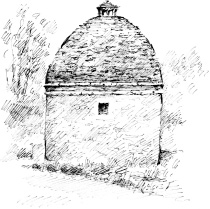
Nearby is a disused quarry that provided stone for Beaumaris Castle and the pillars of the Menai and Britannia bridges.
FROM PENMON, A short, bumpy toll road leads to Anglesey’s eastern tip at Black Point, where there is a lighthouse and an old lifeboat station. A melancholy bell tolls a warning from the rocks in the middle of the treacherous waters that separate the point from Ynys Seiriol (Seiriol’s Island), once known as Priestholm. St Seiriol had a sanctuary on the island, and some scant 6th-century remains can still be seen. He also had a chapel on the mainland at Penmaenmawr, and would travel between the two along a secret sand bank, now vanished beneath the waves of Conwy Bay.
The island is better known today as PUFFIN ISLAND, from the large colony of puffins that once nested there. In the 18th and 19th centuries the colony was almost eradicated by rats and by a food fad of the time – pickled puffin was considered a tasty delicacy.
MOELFRE IS A small village of pastel-painted stone cottages that tumble down to a pebble beach and tiny harbour popular with fisherfolk and yachtsmen. It sits on a rocky headland that has caught out many an unwary vessel rounding Anglesey on its way to or from Liverpool. The Moelfre lifeboat has been involved in countless rescue missions over the last 200 years, most famously in October 1859 when the steam clipper Royal Charter foundered on rocks just to the north, during a fierce storm. The lifeboat crew managed to save 39 lives before the ship broke up, but some 460 men, women and children perished. The ship was returning to Liverpool from the Australian Gold Rush with a cargo of gold, much of which is thought still to be on board the wreck. Frequent efforts have been made to try and recover the haul, allegedly to no avail, although Customs Officers still keep a beady eye on the village for any signs of unexplained extravagance amongst the local inhabitants. The bodies of most of those who drowned are buried at Llanallgo, a little way inland, and there is a memorial on the headland.
Exactly one hundred years later, almost to the day, the Moelfre lifeboat crew saved the eight-man crew of the coaster Hindlea, which had hit rocks below the coastguard station, a rescue that earned RICHARD EVANS, the lifeboat coxswain, his second Royal National Lifeboat Institution gold medal.

Further north, on the cliff top at PORT LYNAS there used to be a semaphore station, part of a system which, in good weather, could relay messages from Holyhead to Liverpool in under a minute. Today ships bound for Merseyside stop here to take on board a pilot to steer them safely into port.
AMLWCH, AN ATTRACTIVE little town on Anglesey’s north coast, is THE MOST NORTHERLY TOWN IN WALES and, for much of the 18th and 19th centuries, was THE COPPER CAPITAL OF THE WORLD as well as THE RICHEST PORT IN WALES.
The source of its wealth, PARYS MOUNTAIN, sits scarred and lifeless just outside the town, a barren, dusty place riven with pits and craters like some sore on Anglesey’s fair face. Evidence has been found that suggests copper was mined here some 4,000 years ago in the Bronze Age, making Parys one of THE EARLIEST MINES IN BRITAIN. And it was copper that brought the Romans to Anglesey. In the 1760s mining started up once again on a small scale and expanded to meet the growing demand for copper until, by the end of the 18th century, Parys Mountain was THE WORLD’S BIGGEST PRODUCER OF COPPER and the site of THE LARGEST OPEN-CAST COPPER MINE IN THE WORLD. The copper was of such a high grade that the Parys Mine Company minted its own coins known as ‘Amlwch Pennies’, stamped with a Druid’s head on the front and its initials, PMC, on the back. These are now highly sought-after collector’s items.

Today, the eerie pink and orange landscape can be explored with the help of a guide. Highlights include the remains of an engine house that once sheltered one of the earliest Cornish beam engines in Britain, and a brown lake full of sulphuric acid at the bottom of the derelict open-cast mine. The unearthly location has also attracted many film and TV companies. Parys Mountain has starred in the BBC television series of Doctor Who and films such as Mortal Kombat, The Annihilation in 1997 and Infestation in 2005.
Amlwch, in the meantime, has settled down to become a quiet seaside town popular with holiday-makers. The harbour that once sent copper around the world now bustles instead with pleasure craft and yachts.
The town’s dry dock was created by enlarging a natural inlet and is thought to be THE ONLY DRY DOCK OF ITS KIND IN BRITAIN.
At Bull Bay is the unique church of OUR LADY, STAR OF THE SEA, built in the 1930s in the shape of an upturned boat by an Italian, G. Rinvolucri, a former prisoner of war.
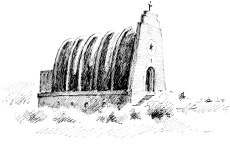
THE LARGEST TOWN in the county of Anglesey, HOLYHEAD is not actually on the island of Anglesey but rather on Holy Island, which stands just off the north-west coast of Anglesey. Its origins are Roman, and the present-day St Cybi’s parish church stands within the thick, 16 ft (5 m) high walls of a 3rd-century Roman fort. In the 5th century, a Celtic monk, St Cybi, built a monastic cell within the protection of these walls, where the existing church now stands. Dating mainly from the time of the Tudors, the church was restored by Sir George Gilbert Scott in the 19th century, and contains some superb stained-glass windows by William Morris and Edward Burne-Jones.
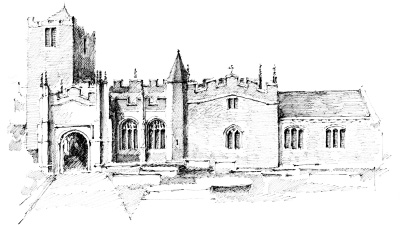
ADMIRALTY ARCH was erected in 1821 to commemorate the visit of George IV and to mark the end of Thomas Telford’s road from London, now the A5. The railway arrived shortly afterwards, cementing Holyhead’s position as THE PRINCIPAL BRITISH TERMINAL FOR THE CROSSING TO IRELAND.
Holyhead’s North Breakwater, designed by James Meadow and completed in 1873, is THE LONGEST BREAKWATER IN BRITAIN. It is 1½ miles (2.4 km) long, shelters 700 acres (283 ha) of water, and took 30 years to build.
To the west is HOLYHEAD MOUNTAIN, AT 720 ft (219 m) the highest point in the county of Anglesey. At the top, as well as glorious views of Anglesey, Snowdonia, the Isle of Man and even, on a clear day, the Wicklow Mountains in Ireland, there are the remains of a hill fort and some ancient hut settlements. A little further west, 410 steps lead down from a car park to SOUTH STACK, a tiny islet linked to Holy Island by a metal footbridge, and crowned with a lighthouse built in 1809. The slow climb back up is rewarded with close views of the numerous sea birds nesting on the steep cliffs.
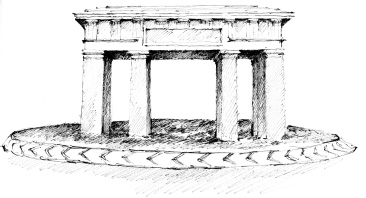
Admiralty Arch
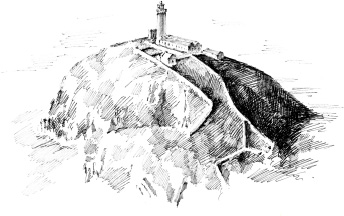
South Stack
IN THE 13TH century, Ednyfed Fychan, Lord Steward to Llywelyn the Great, was granted the lands around Penmynydd as a reward for his services. In 1385 his descendant, OWAIN AP MAREDUDD AP TUDUR, was born at Plas Penmynydd, in the original house on the site. Owain ap Tudur, the ‘Rose of Mona’, fought alongside Henry V at the Battle of Agincourt in 1415 and was made head of the Royal Household. After Henry V died in 1422, Owain, by now known as Owen Tudor, and Henry’s widow Catherine de Valois, daughter of the French King Charles VI, fell in love and secretly married. They had three sons, Edmund, Jasper and Owen. Edmund became Earl of Richmond and married Margaret Beaufort, heiress to the Duke of Somerset and great-granddaughter of John of Gaunt, Duke of Lancaster.

Their son, born at Pembroke Castle in 1457 (see Pembrokeshire), ascended the throne of England in 1485 as Henry VII, exactly 100 years after his grandfather was born at Penmynydd, finally fulfilling Merlin the Wizard’s prophecy that a man from Anglesey would one day sit upon the English throne.
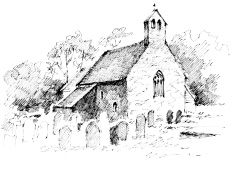
In a chapel of the village church of St Gredifael are the grand alabaster tombs of Henry VII’s great-grand-uncle Gronw Fychan ap Tudur and his wife Myfanwy. Over the years pilgrims have removed bits of the tombs in the belief that they are bestowed with healing powers. There is also a colourful stained-glass window illustrating the royal regalia of the English throne, the Tudor rose and the portcullis of the Beaufort family. Lettering in Welsh around the window translates as ‘unity is as a rose on a river bank and a house of steel on a mountain top’. Ty Dur, or Tudor, is Welsh for house of steel.
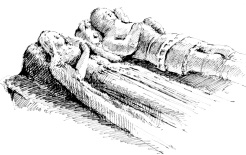
TEN MILES (16 KM) away on Anglesey’s west coast an old grey stone, single-arch packhorse bridge leads into the little fishing village of ABERFFRAW, ancient capital of the Kings of Gwynedd. Celtic Britain was ruled from here for hundreds of years, from not long after the Romans left until the time of Llywelyn the Last and Edward I. Today, little remains to show of the glittering royal court except an arch in the church of St Bueno said to come from the palace of the Princes.
Nearby, beneath the nave of the church at LLANGADWALADR, lies CADFAN, ruler of Gwynedd between AD 616 and 625. His tombstone bears the Latin inscription sapientisimus opinateimus omnium regum – ‘wisest and most renowned of all kings’, and lays claim to being THE OLDEST ROYAL TOMBSTONE IN BRITAIN. The village is named after Cadfan’s grandson Cadwaladr, king of Gwynedd who died of the plague in 664.
A little to the north is another survivor from Aberffraw’s glory days, the tiny island church of ST CWYFAN’S, founded in AD 605 and reached only at low tide, via a causeway. Set in the sea against a backdrop of mountains, this must be one of the most ravishing locations for a church anywhere in Britain. Despite its remoteness, occasional services are still held here.
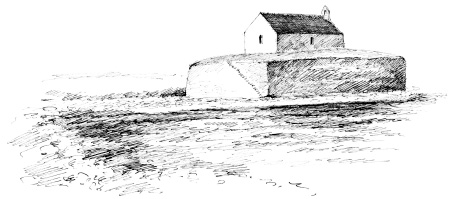
St Cwyfan’s
THE VILLAGE OF NEWBOROUGH was founded at the end of the 13th century by the displaced inhabitants of Llanfaes, moved here by Edward I to make way for his castle at Beaumaris. South of the village is one of the largest areas of sand dunes on the west coast of Britain. In 1992 parts of the lost royal palace of Llys Rhosyr were discovered beneath the sand, and new sections are slowly being uncovered every year.
Beyond the dunes, a walk along the vast, windswept beach leads to YNYS LLANDDWYN, the island where ST DWYNWEN, patron saint of lovers, made her sanctuary. On her feast day, 25 January, the lonely island becomes a place of pilgrimage for courting couples. It can be reached, with difficulty, by those determined enough to brave the elements and clamber across the rocks at low tide. It is exalting to sit upon this bare, romantic outcrop, with the sea breeze blowing in your face and the wide expanse of sand at your back, gazing across the wild, white-capped waves to the distant grey coastline of Lleyn.
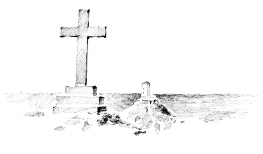
SHINJUKU STATION IN Tokyo may claim to be the world’s busiest station. Clapham Junction may claim to be Europe’s busiest station. But for sheer density of people in a small space, nowhere beats the station at Anglesey’s LLANFAIRPWLLGWYNGYLLGOGERYCHWYRNDROBWLLLLANTYSILIOGOGOGOCH or ‘St Mary’s church in the hollow of the white hazel near a rapid whirlpool and the church of St Tysilio of the red cave’.

Turn off the quiet, nondescript high street of what the locals and the Post Office call Llanfair PG, into the station car park, and you enter a frenetic, parallel world. Vast double-decker coaches buck and hiss as they disgorge their loads by the thousand. The air is thick with the curses of strong men who wave their fists while bumping and scraping their paintwork, as they battle for any parking space that becomes available. Children and tourists yap excitedly, beaming with anticipation.
But surely the people who come here are not just dense in quantity, but also in intellect, for few trains stop here and there is absolutely nothing to see. Except a name – with 58 letters, THE LONGEST PLACE NAME IN EUROPE. THE LONGEST NAME FOR A RAILWAY STATION IN THE WORLD, possibly (see Merioneth). And now THE LONGEST, VALID, SINGLE-WORD INTERNET DOMAIN NAME IN THE WORLD. And a brilliant hoax.
In the middle of the 19th century, a local cobbler, looking to drum up some trade, alighted on the idea of combining the name of the village with that of neighbouring Llantysiliogogogoch to create the longest station name in the world. It worked to perfection and, ever since, the station has been one of the most popular tourist attractions in Wales. Today the real station is almost deserted as the throng patronises the modern, purpose-built visitor centre next door, where you can be issued with THE LONGEST PLATFORM TICKET IN THE WORLD and purchase sung musical versions of the name, guides to its pronunciation in every language, and postcards of the station sign.
The name Llanfairpwllgwyngyllgogerychwyrndrobwllllantysiliogogogoch was used in the 1968 film Barbarella, starring Jane Fonda, as the password for the headquarters of the resistance leader Dildano (played by David Hemmings).
Llanfairpwllgwyngyllgogerychwyrndrobwllllantysiliogogogoch is twinned with the Dutch town of d’Ee.
GLENYS KINNOCK, Member of the European Parliament and wife of the former Labour Party leader Neil Kinnock, was born in Holyhead in 1944.
DAWN ROMA FRENCH, comedienne and actress, best known as one half of the French and Saunders comedy duo, and as the Vicar of Dibley in the BBC television situation comedy of that name. She was born in Holyhead, where her father was stationed with the RAF, on 11 October 1957. She is married to comedian Lenny Henry.
ALED JONES, singer and television presenter, was born in Llandegfan, near Beaumaris, on 29 December 1970.
SIR PATRICK ABERCROMBIE (1879–1957), town planner and co-founder, in 1926, of the Council for the Protection of Rural England. He came up with the idea of green belts around cities to limit their expansion. He is buried in the churchyard at Rhoscolyn on Holy Island, where he had a retirement home.
ROBERT EVERETT (1902–42), winner of the 1929 Grand National on Gregalach at odds of 100–1. In the Second World War he became a fighter pilot and was killed when his Hurricane crashed in January 1942. He is buried in the churchyard at Llanddona, just north of Beaumaris.
Anglesey is THE FIFTH LARGEST ISLAND OFF THE COAST OF BRITAIN and THE LARGEST ISLAND OFF THE COAST OF BRITAIN OUTSIDE SCOTLAND.
Anglesey has A GREATER CONCENTRATION OF PREHISTORIC REMAINS THAN ANYWHERE ELSE IN WALES. Perhaps the best preserved of these is BRYN CELLI DDU, a fine chambered burial mound near Plas Newydd which dates from around 2000 BC. Another Neolithic burial chamber, BARCLODIAD Y GAWRES, can be found on the cliffs north of Aberffraw. This contains THE MOST EXTENSIVE COLLECTION OF STONE AGE WALL PAINTINGS IN WALES. The construction of both these burial places, as well as the chevron and spiral shapes carved on to the stones inside, are similar to those of the celebrated passage graves in the Boyne valley of Ireland, such as Newgrange.
Thanks to its abundant wheatfields, which for a long time fed the people of Wales, Anglesey has always been known to the Welsh as MON MAM CYMRU, the ‘Mother of Wales’. It was the wheatfields, as well as the rich copper deposits at Amlwch, which drew the Romans here and encouraged them to take on the fearsome Druids, who had withdrawn to Yns Mon and made it their headquarters after being driven off the mainland. Under the command of Suetonius, the Romans crossed the sands at Newborough in AD 61 and slaughtered the Druids, who stood amongst the trees brandishing fiery torches and screaming terrible curses in a courageous but forlorn show of defiance.
Built in 1716, the lighthouse on the SKERRIES, off the north-west coast of Anglesey, was THE LAST PRIVATE LIGHTHOUSE IN BRITAIN. Control passed to Trinity House in 1841.
The A5114, which runs for less than 2 miles (3.2 km) between Llangefni and the A5, is THE SHORTEST ‘A’ ROAD IN BRITAIN.
Just outside Llanfair PG is a distinctive octagonal building, one of three surviving tollhouses on the A5 between Llanfair PG and Holyhead. The last toll was charged here in 1895, and the road was THE LAST PUBLIC TOLL ROAD IN BRITAIN, until a congestion charge began to be levied on traffic entering Durham in 2002. THE FIRST EVER MEETING OF THE WOMEN’S INSTITUTE HELD IN EUROPE took place in a house in Llanfair PG in 1915. The Women’s Institute originated in Canada.
In July 1663, Holyhead was the finishing line for THE WORLD’S FIRST OFFICIAL SEA-GOING OPEN YACHT RACE, when the world’s first catamaran, Sir William Petty’s Experiment, beat the Dublin Packet in a race from to Holyhead from Dublin.
Opened in Holyhead in 1949, HOLYHEAD COUNTY SECONDARY was BRITAIN’S FIRST COMPREHENSIVE SCHOOL.
The WYLFA NUCLEAR POWER STATION, on Anglesey’s north coast, is THE LARGEST CAPACITY MAGNOX STATION IN BRITAIN, with an output of some 980 megawatts. Its two Magnox reactors are THE LARGEST OF THEIR TYPE IN THE WORLD. The plant was begun in 1963 and first generated electricity in 1971. Today Wylfa supplies over 40 per cent of Wales’s electricity needs. It is due to be decommissioned in 2010, but discussions are under way on whether to build a new nuclear power station on the site.